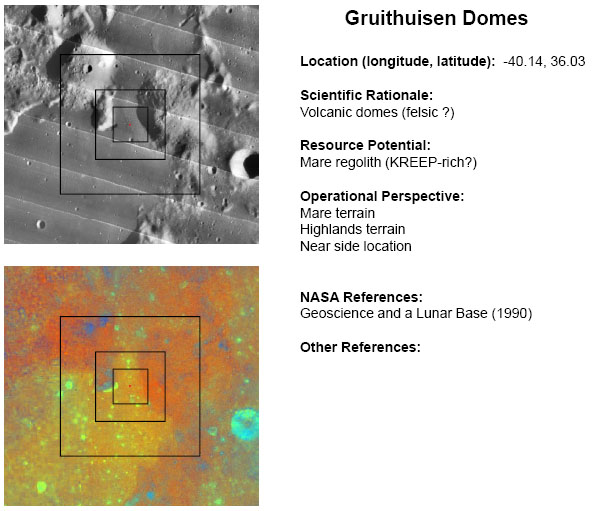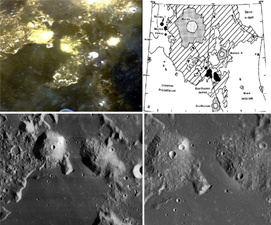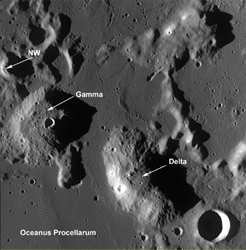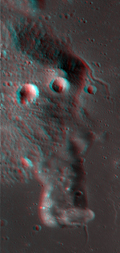RoI - Gruithuisen Domes
Contents
Gruithuisen Domes
(Tier 1 [/Cx35 Region of Interest] for Constellation Program)
Official NASA Overview

source: NASA Cx-LROC Tier 1 Targets (PDF); see expanded details below
Table of Contents
Scientific Rationale
Volcanic Domes (felsic?)
Unlike most lunar volcanic mare domes that generally look much flatter, smoother and smaller, the Gruithuisen Domes have higher and steeper slopes, have much larger volumes of material, and are located on non-mare highlandic rocks. The unusual formation of the domes are believed due to silica-rich, viscous lavas of extremely low UV reflectance (e.g. as defined from the Clementine UVVIS data, their R415/R750 colour ratio -- essentially a measure of TiO2 content of mature basaltic soils -- was low), which occurred at the beginning of the [/Stratigraphy Late Imbrium] period -- 3.85 to 3.72 billion years ago. Like the smaller Mairan domes that lie some 200 km away north-west to the Gruithuisen Domes, they fit into a member-group known as 'red spots' -- areas that are spectrally and morphologically distinct to other features and terrain. The Gruithuisen Domes thus show to have a high albedo signature, a low iron-titanium constituent make-up that is distinctly different to the surrounding mare, and as they happen to lie within the Procellarum KREEP Terrain (PKT), this may suggest a relationship to late-stage rocks-types such as [b]KREEP[/b] (Potassium, Rare Earth Elements, Phosphorus), or even to more evolved highland silicic compositions such as Dacite, Rhyolite and Andesite. Past missions, like Clementine and Lunar Prospector, show that the returned lunar samples so far todate do not fully represent the rock chemistries of the moon's surface or the mechanisms behind lunar volcanism in general. As this has led to a lack of understanding of lunar magmatic evolution, study of the Gruithuisen Domes, or better still, retrieval of samples by a future robotic mission, could provide invaluable information about non-mare volcanism, crustal evolution, and their relationship to other major lunar rock units in the region where they form.- JohnMoore2 JohnMoore2
|
Top Left: Clem-UVVIS Multispectral view from Map-A-Planet. | |
|
|
NASA References
- Geoscience and a Lunar Base (1990) -- A Comprehensive Plan for Lunar Exploration -- Proceedings of a workshop sponsored by NASA, and held at the Lunar and Planetary Institute, Houston, Texas, August 25-26, 1988.
Additional Information
- Size & Heights: The western dome, [/Mons%20Gruithuisen%20Gamma Gruithuisen Gamma] (36.43N, 40.38W), has a diameter of 19 km and is 1320 m high, while the eastern dome, [/Mons%20Gruithuisen%20Delta Gruithuisen Delta] (36.11°N, 39.42°W), which is the largest (possibly made up from three coalescing smaller domes) has a diameter of 27 km and is 1630 m high. Both domes appear to have flat summits, and are covered by small impact craters. The nearby smaller Northwest dome (36.92°N, 40.86°W), has a diameter of 7.5 km with height of 1020 m. Statistical data retrieved from Table 3, Page 39 of Wohler, C. et all in their 2006 paper entitled A Combined Spectrophotometric and Morphometric Study of the Lunar Mare Dome Fields Near Cauchy, Arago, Hortensius, and Milichius -- Icarus, Vol. 183, No. 2, Pp. 237-264, 2006.
- Elemental values: FeO -- Gruithuisen Gamma & Delta between 6 to 10%; TiO2 -- < 1% percent.
- Felsic volcanoes: Consisting predominantly of the lighter elements -- silicon, oxygen, sodium, aluninium and potassium -- they are the most viscous and explosive volcanoes around.
LROC Links
- Featured Image -- Gruithuisen Domes - Constellation Region of Interest
LPOD Articles
Geo Textbook, Volcanic Hinterland, What Makes Mountains, Silicic Domes?.
General Bibliography
- Braden, S. E. et al (2010). Morphology of Gruithuisen and Hortensius Domes: Mare vs Nonmare Volcanism from the 41st Lunar and Planetary Science Conference, 2010.
- Braden, S. et al (2009). LROC NAC Digital Elevation Model of Gruithuisen Gamma - American Geophysical Union, Fall Meeting 2009, abstract #U21C-04. 2009.
- Braden, S. E. et al (2007). Unexplored Areas of the Moon: Nonmare Domes - A White Paper submitted to the Planetary Science Decadal Survey 2013-2022. 2007.
- Hagerty, J. J. et al (2006). Refined Thorium Abundances for Lunar Red Spots: Implications for Evolved, Nonmare Volcanism on the Moon - Journal of Geophysical Research, 111, E06002, doi:10.1029/2005JE002592. 2006.
- Wilson, L. and Head, James W. (2003). Lunar Gruithuisen and Mairan Domes: Rheology and Mode of Emplacement. Journal of Geophysical Research, 108 (E2). 5012. ISSN 0148-0227. 2003.
- Wagner, R. et al (2002). Stratigraphic Sequence and Ages of Volcanic Units in the Gruithuisen Region of the Moon - Journal of Geophysical Research, Vol. 107, No. E11, 5104, doi:10.1029/2002JE001844. 2002.
- Chevral, S. D. (1999). Gruithuisen Domes Region: A Candidate for an Extended Non-mare Volcanism Unit on the Moon - Journal of Geophysical Research, 104 (E7), 16,515-16,529. 1999.
- Petford, N et al (1994). The Ascent of Felsic Magmas in Dykes Lithos, Vol 32, Issues 1-2, Pages 161-168. 1994.
- Head, J. W. and McCord, T. B. (1978). Imbrian-Age Highland Volcanism on the Moon: The Gruithuisen and Mairan Domes - Science, 31 March 1978: Vol. 199. no. 4336, pp. 1433 - 1436, DOI: 10.1126/science.199.4336.1433. 1978.
This page has been edited 1 times. The last modification was made by - tychocrater tychocrater on Jun 13, 2009 3:24 pm


